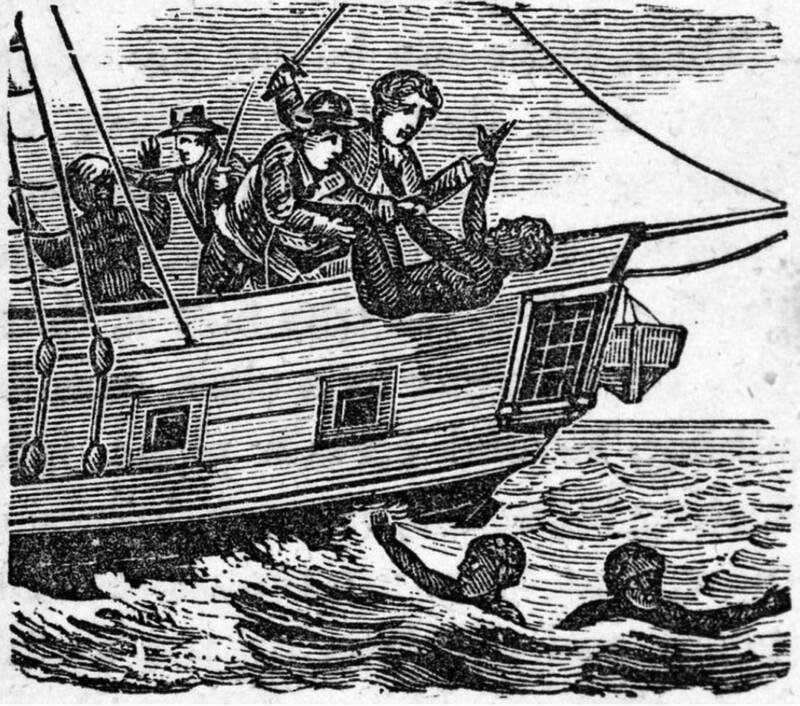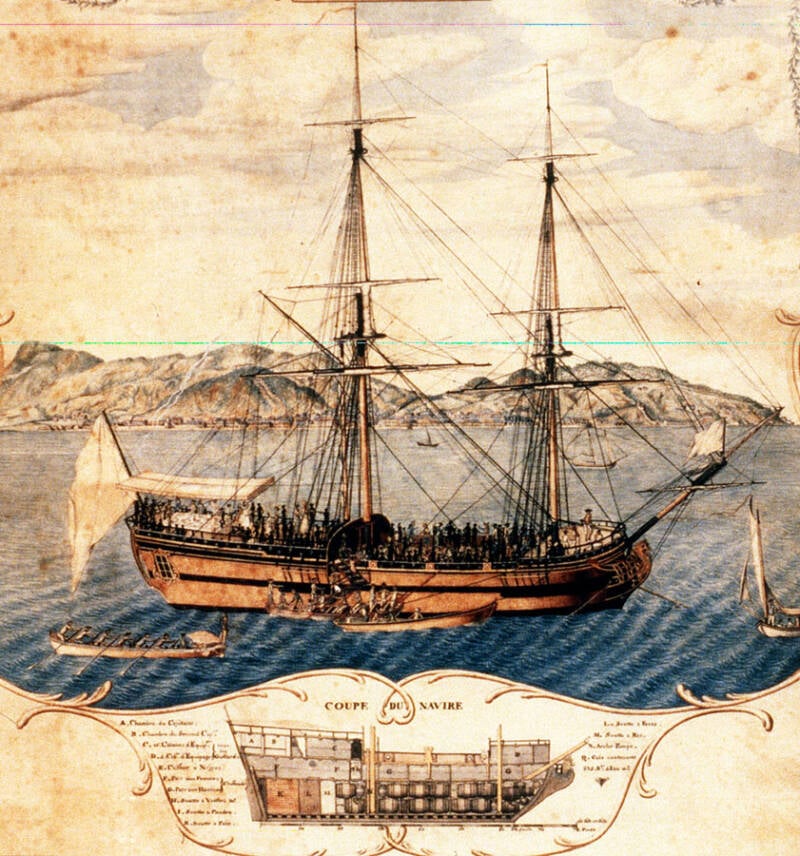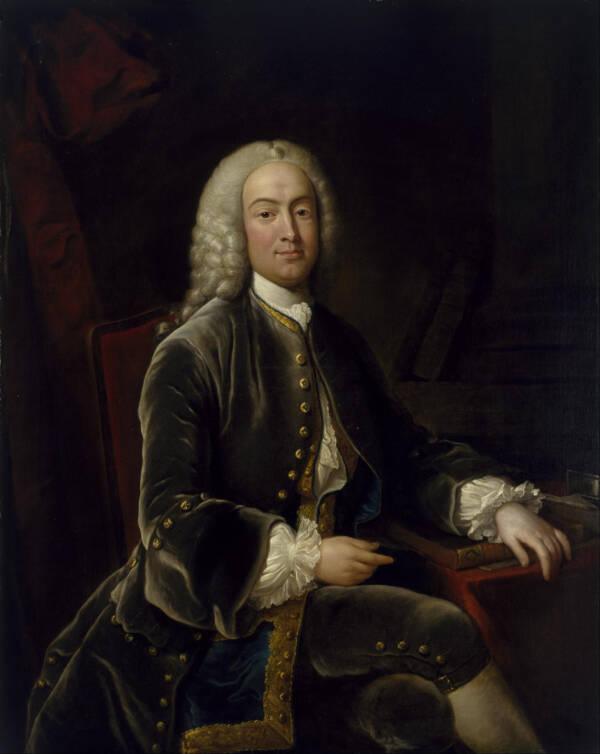In 1781, the crew of the British slave ship Zong threw African captives overboard after the ship started running low on supplies on the way to Jamaica.

Public DomainLike in this print, captive Africans were thrown overboard in the 1781 Zong Massacre.
There’s a patch of sea in the Atlantic Ocean called “the Doldrums” which is famous for its stillness. There’s little wind, little movement. But on one horrific day in 1781, screams punctured the usual calm as a slave ship threw over 100 captive Africans into the ocean in the Zong Massacre.
The crew of the slave ship Zong, battered by illness and running low on water, made the cruel decision when their journey to Jamaica took longer than expected. They jettisoned more than 100 captives over several days, who, still chained, quickly sank beneath the waves.
The Doldrums might have forever kept what happened during the Zong Massacre secret, but once the slave ship arrived at port in Jamaica, its owner tried to recoup his losses by filing an insurance claim. In the aftermath, courts debated not whether the ship’s crew had committed murder but whether they should be compensated for “lost” cargo.
The Doomed Voyage Of The Slave Ship Zong
Before its infamy, the Zong was just one of the many slave ships that transported captive people from Africa across the Atlantic Ocean. In the 18th century alone, an estimated six to seven million Africans were wrenched from their homelands and sold into slavery in the “New World,” per HISTORY.
The Zong, a Dutch ship purchased by slave trader William Gregson in 1781, set out on its doomed journey that August. By the time it left Accra for Jamaica, it had 442 Africans aboard — more than double its capacity.

University of BrightonThe slave ship Zong where the massacre took place.
The Daily Mail reports that some of the enslaved people onboard had spent more than a year aboard the Zong, as the ship had slowly made its way along the African coast, picking up captives. Like on other slave ships, they were crammed below deck where illness soon ran rampant.
The Zong Massacre took place two months later when the crew of the ship, beleaguered by illness and delays, realized they were running low on water.
How The Zong Massacre Unfolded At Sea

Library of CongressA depiction of how enslaved Africans were crammed onto slave ships. When the Zong left Accra, it held over 400 captives, or double its capacity.
The Zong was already suffering from illness and low water supplies when someone onboard made a terrible error. After spotting Jamaica, the Daily Mail reports they erroneously believed that their destination was actually a hostile French colony. So, the ship sailed away.
By the end of November, the Zong had sailed straight into a slice of the Atlantic Ocean called “the Doldrums,” where a lack of wind brought their journey to a halt. According to Black Past, disease quickly spread throughout the stranded ship, killing 17 crew members and more than 50 of the Africans.
On Nov. 29, 1781, the surviving members of the Zong crew decided to take action. They made the ruthless decision to throw dozens of their African captives overboard in order to preserve the ship’s water supplies.
Over the next several days, the crew of the Zong advanced their murderous plot. The Daily Mail reports that they jettisoned over 50 women and children on the first day, then continued with almost 70 more people, who, chained, sank screaming into the sea. Though one English-speaking African begged the crew to let them live, promising that he and the others could live without food or water until they reached Jamaica, he was ignored.

Musée de la MarineA depiction of the 1781 Zong Massacre.
In all, 133 captive Africans were killed during the Zong Massacre. Most were forcibly thrown overboard by the ship’s crew, but some chose to jump and take their own lives. By the time the Zong finally arrived in Black River, Jamaica, it had just 208 enslaved Africans onboard.
What had happened at sea might have stayed a grisly secret among the crew, but after the ship’s arrival in Jamaica its owner William Gregson filed an insurance claim for his lost “cargo.”
The Legal Aftermath Of The Zong Massacre
As History Extra explains, slavers like William Gregson didn’t see captive Africans as people but as cargo. To recoup his losses, he filed an insurance claim, arguing that a navigational error had given the ship’s crew no choice but to jettison dozens of African captives to save the others.
His insurers refused to pay, so Gregson took them to court. He won a legal victory which agreed that the murdered captives were the same as lost cargo. But when the insurers appealed the decision — arguing that the crew was at fault, but not that they’d committed murder — the case landed on the desk of the British judge Lord Mansfield.
“The case of the slaves was the same as if horses had been thrown overboard,” Mansfield noted. “It is a very shocking case…”

Public DomainLord Mansfield compared the Zong Massacre to throwing horses overboard.
The judge ordered a retrial in order to investigate claims that the captain and his crew had been at fault. Though The Guardian notes that such a trial never took place, the Zong Massacre wasn’t forgotten.
Instead, the story was picked up by Olaudah Equiano, a formerly-enslaved abolitionist who’d been kidnapped from Africa at the age of eight. Equiano notified anti-slavery campaigner Granville Sharp, who argued that the Zong Massacre was nothing short of murder. He even tried — to no avail — to press criminal charges against the ship’s crew.
The crew was never charged, but the story of the Zong Massacre quickly spread. Sharp was able to enlist the help of local Quakers, who History Extra reports began their own campaign against the slave trade. Before long, abolitionism spread across England.
“The Zong case lit the blue touch paper in England,” James Walvin, who wrote a book on the Zong Massacre called The Zong: A Massacre, the Law & the End of Slavery, told The Guardian. “[I]t aroused abolitionist anger, and fed into the initial campaigns against the Atlantic slave trade.”
Though Britain abolished the slave trade in 1807, it took another few decades for the Slavery Abolition Act of 1833 to end slavery in British colonies.
Today, the Zong Massacre stands as a largely forgotten but important chapter in the terrible history of the Atlantic slave trade. Not only does it encapsulate the horrors that some captive Africans faced at sea, but it also helped raise legal — and moral – questions about slavery itself.
After reading about the Zong Massacre, go inside the wrenching story of Igbo Landing, when dozens of captive Africans chose to drown themselves rather than submit to slavery. Or, discover the story of Queen Nzinga, the 17th-century African ruler who fought off slavers.





